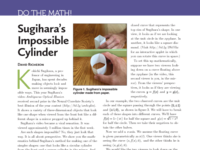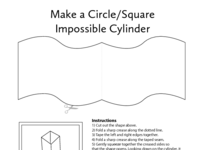Ambiguous Optical Illusion (English)
This is a translation of "Ambiguous Optical Illusion" made by "KyeongYong Kim (김경용)".
Japanese engineering professor Kokichi Sugihara has been creating the seemingly impossible shapes and movements of objects for decades. The video below is Sugihara's Ambiguous Optical Illusion, which took 2nd place in the Best illusion of the year contest in 2016, and was viewed about 5 million times in its first week.
A quadrilateral with four points , , , as vertices on the coordinate plane can be divided into parts with coordinates above and below, and expressed as a curve using parameters as follows.
Also, a circle whose center is the origin and a radius of length can be expressed as a curve using parameters as follows by dividing the -coordinate into parts with or more and less than 0.
Let A and B be the points on the curve r(t),c(t) for each .
Assuming that the object is viewed at 45°, the vector in the direction toward the rectangle and the vector in the direction toward the circle are (0,1,1) and (0,-1,1) respectively.
A straight line passing through point with a direction vector of and a straight line passing through point with a direction vector of using the parameter as follows:
If the intersection of two straight lines is , then the coordinates of the point are as follows:
i.e. curve will appear as half a rectangle or an ellipse depending on the viewing direction.
In the same way, the rest of the curve can be obtained by applying the same method to the other half of the rectangle and semicircle.


